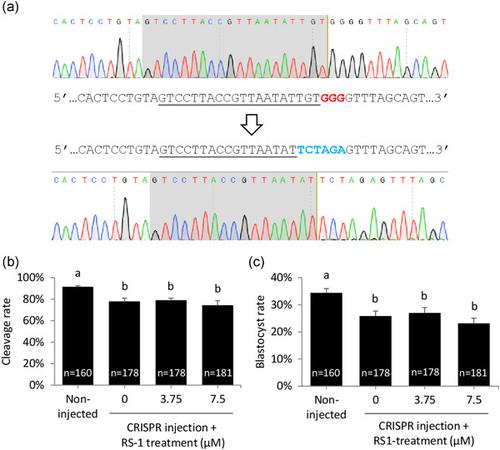当前位置:
X-MOL 学术
›
Mol. Reprod. Dev.
›
论文详情
Our official English website, www.x-mol.net, welcomes your feedback! (Note: you will need to create a separate account there.)
RS-1 enhances CRISPR-mediated targeted knock-in in bovine embryos.
Molecular Reproduction and Development ( IF 2.5 ) Pub Date : 2020-03-30 , DOI: 10.1002/mrd.23341 I Lamas-Toranzo 1 , A Martínez-Moro 1, 2 , E O Callaghan 3 , G Millán-Blanca 1 , J M Sánchez 3 , P Lonergan 3 , P Bermejo-Álvarez 1
Molecular Reproduction and Development ( IF 2.5 ) Pub Date : 2020-03-30 , DOI: 10.1002/mrd.23341 I Lamas-Toranzo 1 , A Martínez-Moro 1, 2 , E O Callaghan 3 , G Millán-Blanca 1 , J M Sánchez 3 , P Lonergan 3 , P Bermejo-Álvarez 1
Affiliation

|
Targeted knock‐in (KI) can be achieved in embryos by clustered regularly interspaced short palindromic repeats (CRISPR)‐assisted homology directed repair (HDR). However, HDR efficiency is constrained by the competition of nonhomologous end joining. The objective of this study was to explore whether CRISPR‐assisted targeted KI rates can be improved in bovine embryos by exposure to the HDR enhancer RS‐1. In vitro produced zygotes were injected with CRISPR components (300 ng/µl Cas9 messenger RNA and 100 ng/µl single guide RNA against a noncoding region) and a single‐stranded DNA (ssDNA) repair template (100 ng/µl). ssDNA template contained a 6 bp Xba I site insert, allowing targeted KI detection by restriction analysis, flanked by 50 bp homology arms. Following microinjection, zygotes were exposed to 0, 3.75, or 7.5 µM RS‐1 for 24 hr. No differences were noted between groups in terms of development or genome edition rates. However, targeted KI rates were doubled in the group exposed to 7.5 µM RS‐1 compared to the others (52.8% vs. 25% and 23.1%, for 7.5, 0, and 3.75 µM, respectively). In conclusion, transient exposure to 7.5 µM RS‐1 enhances targeted KI rates resulting in approximately half of the embryos containing the intended mutation, hence allowing direct KI generation in embryos.
中文翻译:

RS-1增强了牛胚胎中CRISPR介导的靶向敲入。
靶向的敲入(KI)可以通过簇状规则间隔的短回文重复序列(CRISPR)辅助同源定向修复(HDR)来实现。但是,HDR效率受到非同源末端连接竞争的限制。这项研究的目的是探讨通过暴露于HDR增强子RS-1是否可以提高牛胚胎中CRISPR辅助的靶向KI率。向体外产生的受精卵注射CRISPR组分(针对非编码区的300 ng / µl Cas9信使RNA和100 ng / µl单向导RNA)和单链DNA(ssDNA)修复模板(100 ng / µl)。ssDNA模板包含6 bp Xba我位点插入,允许通过限制性分析进行靶向KI检测,侧翼为50 bp同源臂。显微注射后,将受精卵暴露于0、3.75或7.5 µM RS-1中24小时。两组之间在发育或基因组编辑率方面没有差异。但是,与7.5 µM RS-1接触的组中,目标KI率是其他组的两倍(分别为7.5、0和3.75 µM,分别为52.8%,25%和23.1%)。总之,短暂暴露于7.5 µM RS-1可以提高目标KI发生率,导致大约一半的胚胎含有预期的突变,因此可以在胚胎中直接产生KI。
更新日期:2020-03-30
中文翻译:

RS-1增强了牛胚胎中CRISPR介导的靶向敲入。
靶向的敲入(KI)可以通过簇状规则间隔的短回文重复序列(CRISPR)辅助同源定向修复(HDR)来实现。但是,HDR效率受到非同源末端连接竞争的限制。这项研究的目的是探讨通过暴露于HDR增强子RS-1是否可以提高牛胚胎中CRISPR辅助的靶向KI率。向体外产生的受精卵注射CRISPR组分(针对非编码区的300 ng / µl Cas9信使RNA和100 ng / µl单向导RNA)和单链DNA(ssDNA)修复模板(100 ng / µl)。ssDNA模板包含6 bp Xba我位点插入,允许通过限制性分析进行靶向KI检测,侧翼为50 bp同源臂。显微注射后,将受精卵暴露于0、3.75或7.5 µM RS-1中24小时。两组之间在发育或基因组编辑率方面没有差异。但是,与7.5 µM RS-1接触的组中,目标KI率是其他组的两倍(分别为7.5、0和3.75 µM,分别为52.8%,25%和23.1%)。总之,短暂暴露于7.5 µM RS-1可以提高目标KI发生率,导致大约一半的胚胎含有预期的突变,因此可以在胚胎中直接产生KI。



























 京公网安备 11010802027423号
京公网安备 11010802027423号